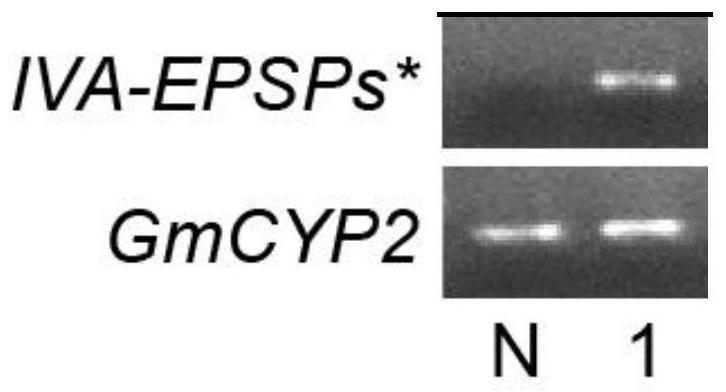Cultivation method of glyphosate-resistant transgenic Glycine max(L.).Merr
A technology of genetically modified soybean and cultivation method, which is applied in the field of cultivation of glyphosate-resistant genetically modified soybean, can solve the problems of time-consuming and labor-intensive, low efficacy, inability to timely control large area, etc., and achieve the effect of improving planting benefit and reducing labor cost.
- Summary
- Abstract
- Description
- Claims
- Application Information
AI Technical Summary
Problems solved by technology
Method used
Image
Examples
Embodiment 1
[0032] Example 1. Construction of plant expression vectors
[0033]The construction process of the transformation vector of the present invention is as follows: use XhoI enzyme digestion to remove the hpt gene in the pCAMBIA1300 vector, and then connect the UTR-CTP-EPSPs fragments with XhoI sticky ends at both ends to the carrier from which the hpt gene has been removed to obtain the final Expression vector pTWGM1 (map as figure 2 shown). The full length of the EPSPs gene is 1374bp, and a 100bp UTR sequence and a 228bp chloroplast localization signal peptide CTP are added at its 5' end. The plasmid of the final plant expression vector pTWGM1, whose nucleotide sequence is shown in SEQ ID NO: 1, was introduced into Escherichia coli DH5α by electroporation, and after sequencing verification, it was then introduced into Agrobacterium strain EHA105 to form a transformed engineering strain. Store in a -80°C refrigerator for later use.
Embodiment 2
[0034] Example 2. Agrobacterium-mediated genetic transformation of soybean
[0035] 2.1 Chlorine disinfection of soybean seeds
[0036] Select soybean seeds that are plump, free of disease spots and with intact seed coats, sterilize them with chlorine gas generated by the reaction of hydrochloric acid and sodium hypochlorite in a fume hood for 3 hours, then put them into an aseptic operating table to ventilate for 30 minutes, and then fully soak them in sterile water overnight.
[0037] 2.2 Soak the seeds overnight
[0038] The sterilized soybean seeds were selected and fully soaked in sterile water overnight.
[0039] 2.3 Isolation of explants
[0040] Soybean seeds soaked overnight were cut in half along the direction of embryo growth, the seed coat was discarded, part of the terminal bud was cut off, and a wound was vertically drawn near the cotyledon node along the cotyledon axis, so that each sterile Two cotyledonary node explants are available from soybean seeds for g...
Embodiment 3
[0066] Example 3. PCR positive detection of transgenic regenerated plants
[0067] The total DNA of soybean leaves was extracted by CTAB method (Document: Murry & Thompson, 1980). The design of PCR primers was completed using Primer Premier 5 software. The two primers used for the amplification of the I.variabilis-EPSPs* gene (subsequently abbreviated as IVA-EPSPs) are:
[0068] IVA-EPSPsF: 5'-ATTAGCGCTAGGGACGTGAG-3', with
[0069] IVA-EPSPsR: 5'-ATACGCTCCCCACATCCTGTC-3'.
[0070] The PCR product size is 593bp. PCR reaction system: 20ng template DNA, 2μl 10×PCR buffer, 0.3μl IdNTP (10mM), 0.3μl IVA-EPSPsF primer (10μM), 0.3μl IVA-EPSPsR primer (10μM), 1U rTaq, supplemented with ddH 2 0 to 20 μl. PCR reaction program: pre-denaturation at 94°C for 5 minutes, denaturation at 94°C for 30s, annealing at 57°C for 30s, extension at 72°C for 30s; repeat 32 cycles; 72°C, 5min; 25°C, 2min. The amplified products were detected by electrophoresis on 0.8% agarose gel. to all T 0 Th...
PUM
 Login to View More
Login to View More Abstract
Description
Claims
Application Information
 Login to View More
Login to View More - R&D
- Intellectual Property
- Life Sciences
- Materials
- Tech Scout
- Unparalleled Data Quality
- Higher Quality Content
- 60% Fewer Hallucinations
Browse by: Latest US Patents, China's latest patents, Technical Efficacy Thesaurus, Application Domain, Technology Topic, Popular Technical Reports.
© 2025 PatSnap. All rights reserved.Legal|Privacy policy|Modern Slavery Act Transparency Statement|Sitemap|About US| Contact US: help@patsnap.com



